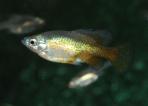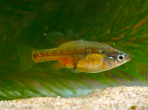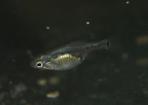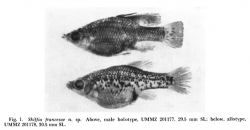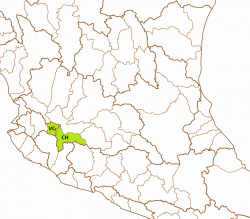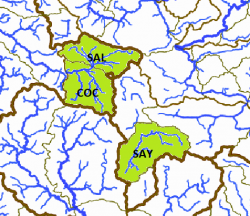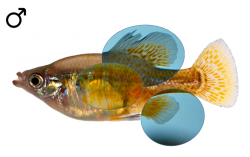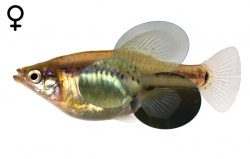Skiffia francesae
KINGSTON, D. I. (1978): Skiffia francesae, a new Species of Goodeid Fish from Western México. Copeia (3): pp 503-508
Collection-number: University of Michigan Museum of Zoology, Cat. No. UMMZ-201177.
The Holotype is an adult male of 29.5mm standard length, collected by R. R. Miller and J. M. Fitzsimons on February the 22nd,1970. Together with the Holotype were taken an adult female Allotype (UMMZ-201178) of 30.5mm standard length, 146 Paratopotypes (UMMZ-189588), 22-37mm SL, and 57 juvenile to adult Paratopotypes (UMMZ-172223), 29-43mm SL.
The left picture shows the types of Skiffia francesae, the right one a drawing of a near-term young fish:
The Holotype was collected in the Río Teuchitlán, below and just E of Teuchitlán, near the road between HW 70 and Etzatlán in Jalisco.
The species was named by D. Kingston after R. R. Miller's wife, Frances H. Miller, in recognition of her help in furthering our understanding of Mexican fishes.
The genus was erected by S. E. Meek in 1902 to honour Frederick James Volney Skiff, the 1st director of the Field Columbian Museum. Taking the latinized female version of his surname, Skiffia can be translated with "Skiffs one".
none
The Golden Skiffia is endemic to the Mexican federal state of Jalisco. It was historically only known from the Río Teuchitlán in the Río Ameca headwaters and from the Río Ameca itself about 12km E of the town of Ameca. Individuals collected in 2007 from the El Molino pond in the endorheic Laguna de Sayula basin also belong to this species, and those from the Presa La Ciénaga (Presa Buenavista), upper Río Ameca drainage, should be Golden Skiffia as well due to the drainage (determined as Skiffia multipunctata in 1963, so before Skiffia francesae was described). Specimens from a historical collection (1939) of the Splotched Skiffia by Miller in a river near Santa Cruz de las Flores, endorheic Laguna Atotonilco drainage, eventually belonged to Skiffia francesae as well due to the hydrographic history of this basin (Zacoalco paleolake included parts of the upper Río Ameca drainage), but this is uncertain. However, this species disappeared from all of these habitats and only persists in aquariums. Two subpopulations are recognized: The Upper Río Ameca subpopulation (type subpopulation) and the Laguna de Sayula subpopulation. Both are regarded Extinct in the Wild. The bold names are the ones officially used by the Instituto Nacional de Estadística y Geografía; nevertheless, other ones might be more often in use or better known and therefore prefered.
ESU ist short for Evolutionarily Significant Unit. Each unit expresses an isolated population with different genetic characteristics within one species. ESU's can be defined by Molecular genetics, Morphology and/or Zoogeography and help in indicating different phylogenetic lineages within a species. The abbreviation for an ESU is composed of the first 3 letters of the genus, followed by the first 2 letters of the species name and an ongoing number in each species.
We recoginze two ESU's within Skiffia francesae: Skifr1 is in use for fish from the Río Ameca basin, in fact, for the only population in culture from the type location from the Río Teuchitlán. On the other hand, there is only one single population known from the Sayula valley. For this population, we have chosen Skifr2.
The left map shows the Lago de Chapala (CH) basin from the Hydrographic Region Lerma-Santiago and the Presa La Vega-Cocula (VC) basin from the Hydrographic Region Ameca on a Mexico map. The right ma shows the rós Salado (SAL) and Cocula (COC) subbasins. The first one bares the type locality of this species, its occurence in the other one is very likely. In 2007 it was additionally discovered in the Laguna de Sayula subbasin (SAY), but one stock (erronously labeled as Skiffia lermae) was already known since the middle of the 1990's. It might have occured additionally in the endorheic Laguna de San Marcos subbasin, connecting both areas of occurence, but as the distribution of fish between the populated watersheds is not fully understood, it is not considered on this map here:
International Union for Conservation of Nature (IUCN): Extinct in the Wild
Distribution and current conservation status of the Mexican Goodeidae (Lyons et al., 2019): Extinct in the Wild/no records since 2008: „This species had long been thought to be endemic to the Teuchitlán Springs in the upper Ameca River basin and was already believed extinct in the wild when it was first formally described as a species in 1978 (Kingston, 1978; Miller et al., 1989). Fortunately, captive populations exist in North America and Europe, although many of these are inbred (Domínguez-Domínguez et al., 2005). In 2007, Omar Domínguez-Domínguez discovered a new population of Skiffia that suggested that S. francesae might still persist in wild. These fish were found at the El Molino spring pond near the town of Cuyucapán in the endorheic Lake Sayula basin, which is located ca. 80 km south of the Teuchitlán Springs. Some individuals from El Molino appeared identical to S. francesae, whereas others had pigmentation that was more reminiscent of S. multipunctata. Genetically, the El Molino fish were more similar to S. francesae than to S. multipunctata. Consequently, we have chosen to treat the two populations as separate ESUs of S. francesae, Skifr1 for Teuchitlán and Skifr2 for El Molino. Unfortunately, the El Molino population was eliminated when the pond dried completed during a drought in 2010. Thus, both ESUs are extinct in the wild. Moderate numbers of captive populations of Skifr1 exist in Mexico, the United States, and Europe, but captive populations of Skifr2 are scarce.“
NOM-059-SEMARNAT-2010: Categoría de riesgo (Category of risk): E - extinguido (extinct)
The former habitat in Teuchitlán was a quiet, thermal and clear to murky water with only a slight current. Substrate was deep mud with a few rocks, silt and sand. A few species of aquatic plants were present, comprising Eichhornia, Pistia, Ceratophyllum and Potamogeton. The Golden Skiffia prefered depths of less than 0.5m. Miller and Fitzsimons measured watertemperatures between 24 and 26°C (February 1976). The water was heavily polluted. A survey of the GWG to this habitat in 2016 revealed that the habitat still looks almost the same, except for the fact, that the pollution has stopped.
A survey of the Cuyacapán spring in the endorheic Laguna de Sayula basin in the same year showed clear water, the bank structured with roots of different trees (mainly Ficus) and reed areas. The substrate was similar to the former habitat in Teuchitlán. The only fish encountered were young specimens of Lepomis and Micropterus, but no Goodeids. The nearby El Molino pond, where the Skiffia and few more species had been collected in 2006, had murky water. Surprisingly and additionally to Tilapia and Poeciliopsis infans, Zoogoneticus purhepechus could be found. A species, that was declared extinct for this basin and the pond. Skiffia francesae however was gone.
Kingston documented fourteen broods from a wild caught fish. The mean number of young per brood were nine, with a range from five to fifteen. The size of the newborn ranged from 8.5 to 10.7mm SL (based on three broods).
The gut is about two to three times the length of the fish. Kingston documented the content, mainly pennate diatoms, some (probably Ulotrichales et al.) filamentous algae, one small snail and a few pollen grains. The teeth are mainly bifid in both rows. This species has definitely mainly herbivorous feeding habits grazing aufwuchs and algae on vertical structures. Another indication for this feeding behaviour are the upturned lips and the wedge-shaped head.
Males are bright gold with superimposed gray cast, especially intense in courting. Courting males show gray borders on the dorsal, anal and caudal fins and gray pelvic fins. There is a black crescent present at the base of the caudal peduncle. In non-courting males, the gold colouration is most evident in the dorsal, anal and caudal fins and faintly present along the caudal peduncle. Some scattered, small gray spots may occur at the base of the caudal fin and on the dorsal fin. Females and juveniles are gray-green with scattered small black flecks along the lateral scale row and the dorsal surface. The fins are clear. The base of the caudal peduncle has got a small black crescent.
Males and females of the Golden Skiffia are quite easy to distinguish. The safest characteristic is the Splitfin in males, means the for Goodeinae typical mating organ formed by a notch after the first seven shortened rays of the Anal fin. Additionally, male Skiffia francesae have a much bigger and notched Dorsal fin than females, giving it a serrated appearance on its anterior part. Males are typically more colourful and show yellow flanks and unpaired fins.
Dolores Kingston in her original description (1978) designated Skiffia francesae as a dwarf-species, evolved from Skiffia multipunctata, and indeed, the Golden Skiffia is very closely related to the Splotched Skiffia. The estimated separation of both species happened only a 0.4 Million years ago and the differences in mitochondrial genes are marginal, so there are strong arguments to summarize both of them and treat Skiffia francesae as a synonym to multipunctata. However, there are little differences in the body-shape, the size and the colouration, so until new results change our understanding substantially, both are still treated as separate species.
The species lived in the Río Teuchitlán and disappeared from this river by competition through Xiphophorus maculatus and other Poecilids, pollution and fragmentation and modification of the springs into a water recreation area. The Río Teuchitlán, former resembling a paradisiac river, is nearly completely altered and many former species have gone. This situation has been the driving force for Ivan Dibble (who loved that river) to start the Mexico Fish Ark Project to rescue endangered fish in Mexico. Meanwhile, with 2017, two of the already gone fish species, Zoogoneticus tequila and Notropis amecae have been brought back to this place and successfully reintroduced by a team from the biological faculty of the university of Morelia, headed by Omar Domínguez Domínguez. Delayed by the Covid pandemic situation of 2020, a similar action for the Golden Skiffa is planned for and will hopefully take place in 2021 and open a new chapter for this gorgeous little fish.
In 2007, a colourful Skiffia like fish was found in the Laguna de Sayula valley (El Molino pond at Cuyacapán). From size and colouration, it resembles very closely francesae. Phylogenetically, it ranges between francesae and multipunctata, but being definitely closer to francesae (however, even multipunctata is very close to francesae as mentioned above), so it is regarded as Skiffa francesae, following Domínguez-Domínguez (pers. com., 2011). In 2010, the pond dried out and so even this population became extinct in the wild. On a survey of the GWG in 2016, the pond revealed from native fish species only Zoogoneticus purhepechus and Poeciliopsis infans, but none of the other native fish found a decade before ("Xenotoca" cf. melanosoma, Skiffia francesae, Ameca splendens). Already in the middle of the 1990's (Rosales-Figueroa, 1995), there was a report of Skiffia lermae (for sure a wrong identification) from a spring in the northern part of the Laguna de Sayula drainage, but this spring had dried up totally when a group of the GWG surveyed (2019) all the springs mentioned in this thesis. None of these springs held water any longer.
James Langhammer crossbred Skiffia multipunctata and francesae in 1988. The hybrids had been fertile over generations, beautifully coloured with big black blotches on the sides and therefore called "Black Beauties". If some of these hybrids still exist in the United States is told differently and uncertain therefore.
Looking on the biotopes of Skiffia francesae, they suggest the species may prefer a habitat with none to moderate current, structured with gravel, rocks, roots, branches, fallen leaves and submerse or/and river bank vegetation. Fry is usually not eaten, but it may depend on the quantity and quality of food and on the number of places to hide, so it is easy to get a flock breeding colony.
The recommended tank size is at least 60 liters, bigger tanks with a generous base and little height (25cm are enough) are better for sure. With few rocks or roots and dense vegetation in the corners and backside of the tank well structured tanks combined with some roots and/or wood seem to do best with this species. The current should be moderate, specially as the species is adapted to a high oxygene level (at least 8mg/l).
In the wild, the species feeds mainly from algae and aufwuchs, but also from small invertebrates, so feeding with similar food like algae grown on feeding stones, blanched or boiled vegetables, water fleas and other small food from animalistic sources will be best for this predominantly herbivorous fish. In aquarium, it feeds also well from flake food, granulate and even tablets, additionally given Nauplia of Brine Shrimps are eaten greedy. The species is not really shy, but likes to use hiding spots to observe the surrounding.
Concerning water quality, this species is in need of bigger water changes (60-80% every week) like most of the Goodeids, especially river and spring inhabiting species, so an automatic water changing system can be helpful. Otherwise, in combination with constant temperatures higher than 24°C, fish may get sick, lose resistance against diseases and age too fast. So for keeping the strain healthy and strong, give the fish a rest during winter time with temperatures lower than 20°C for 2 or 3 months so they stop producing fry. In spring, when the temperature slowly increases, they will start spawning at 20°C and won't stop until it gets colder again or when it gets too warm (24°C).
This species is doing very well when is kept in the open from spring to fall, starting when the water temperature by day exceeds 17°C and cold periods are no longer expected. Bring them out in the early afternoon, the time of the day with the highest water temperature. During the warm summer, reproduction will stop and may occur again in fall. Bring the fish in before the water temperature deceeds 17°C by day and keep them cool for the first days, then slowly raise the temperature but try to stay below 20°C over the winter time.
Here each species are assigned populations of fish in husbandry and in brackets aliases of these locations to assist in identifying own stocks. Each population is assigned a unique Population-ID, composed by the ESU, the subbasin where this population is occurring (three capital letters) and a unique location identifier.
Populations in holding:
1. Skifr1-SAL-RTeu
Population: Río Teuchitlán (aka Teuchitlán)
Hydrographic region: Ameca
Basin: Presa La Vega-Cocula
Subbasin: Río Salado
Locality: RíoTeuchitlán E of Teuchitlán
2. Skifr2-SAY-Say
Population: Sayula (aka Tanque el Molino de Cuyacapán, Cuyacapán spring, Cuyacapán, Skiffia sp. Sayula, Skiffia sp. V188)
Hydrographic region: Lerma-Santiago
Basin: Laguna Chapala
Subbasin: Laguna de Sayula
Locality: small spring at the old mill of Cuyacapán, S of Cuyacapán, about 400m N of the Agua Azul spring




